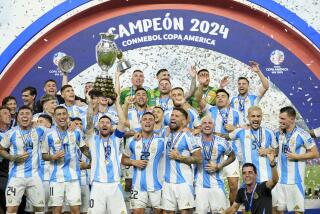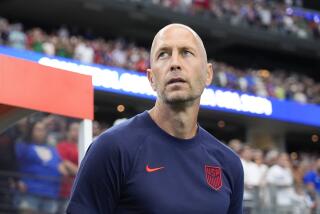This Copa is filled with history, talent
- Share via
Long before there was a World Cup, there was a Copa America.
Argentina’s Lionel Messi, the world’s finest soccer player, will smile when he tells you that. So will Uruguay’s Diego Forlan, the best player at the 2010 World Cup in South Africa. So will Neymar, the Brazilian teenager who is the subject of a $45-million bidding war among five leading European clubs.
The Copa America has an almost 100-year history -- the first edition was played in 1916 -- and that is a matter of great pride among South Americans. No other continental championship is older.
On Friday, the 43rd edition of the tournament starts in Argentina, and Messi, Forlan, Neymar and dozens of other top-name players will be there. The event, which runs through July 24, will be played in eight Argentine cities.
It is also being played in the dead of the Argentine winter, but if the quality of soccer in the 12-nation tournament -- the under-23 teams of Mexico and Costa Rica are taking part as invited guests -- lives up to previous editions, that should be enough off shake off any chills.
Argentina, as host, is the logical favorite and the pressure is on Coach Gabriel Batistuta’s team, which is purposely being molded around Messi to resemble, in both tactics and style, European club champion Barcelona.
“We are always obliged to win, no matter where we are,” Messi recently told the Spanish-language newspaper El Pais. “Argentina is always among the favorites and has to fight to win everything, and more so playing at home in front of our own fans.”
An Argentine success is long overdue. The country might have been South American champion 14 times -- a record it shares with Uruguay -- but it was 1993, in Ecuador, when Argentina last walked off with the prize after Batistuta’s two goals broke Mexican hearts in the final.
More recently, Brazil has dominated, winning four of the last five tournaments, including the 2004 and 2007 editions, to bring its Copa America haul to eight.
Coach Mano Menezes would like to make it nine by winning the third in a row, but he has completely recast the team since the 2010 World Cup in South Africa, with an eye on the 2014 World Cup, which Brazil will stage.
“The renovation has been intense,” Menezes said. “If you look at the names today, there are only four players who were starters in the last World Cup.”
Because Brazil does not have to qualify for 2014, the Copa America will be Brazil’s only chance to test its new players under competitive conditions until the 2013 Confederations Cup, which Brazil also will stage.
“We will use all opportunities to prepare for the World Cup,” Menezes said recently.
Argentina and Brazil are favored to square off in the July 24 final, which is the only game being played in Buenos Aires, but Uruguay, too, is a legitimate title contender.
Coach Oscar Tabarez’s Uruguay team was the highest-finishing South American side in South Africa last year when it took fourth place in the World Cup behind the inspired play of Forlan.
“He is in very good physical condition,” Tabarez said of the 32-year-old. Uruguay’s success or failure, however, is more likely to depend on younger forwards Luis Suarez and Edinson Cavani.
“We know what we’re capable of and are ready to play our role,” Cavani said recently.
Paraguay, which reached the last eight of the 2010 World Cup, also could make a run at the Copa. “We’re looking to reach the final,” said the team’s Argentine coach, Gerardo Martino.
If so, Paraguay will be relying heavily on forward Lucas Barrios, just as Chile’s hopes could hinge on winger Alexis Sanchez and Colombia’s chances ride on the form of striker Radamel Falcao.
Attacking players, in fact, are in such good supply at this Copa America that it could be one of the most viewable and enjoyable tournaments yet.
But in the end it should still come down to the two teams with the most offensive options: Argentina and Brazil.
In addition to Messi, Argentina can turn to such goal-grabbing players as Carlos Tevez, Gonzalo Higuain, Diego Milito, Sergio Aguero and Angel Di Maria, with Javier Pastore and Ever Banega making things happen.
Brazil, meanwhile, is putting together an attack that probably will see up-and-coming playmaker Paulo Henrique Ganso and Ramires behind the trio of Neymar, Robinho and Alexandre Pato.
The big Copa question of 2011 thus becomes: Can new-look Brazil make it three in a row and win the tournament on Argentine soil or will the high-powered home team finally end its 18-year drought?
The smart money is on Argentina.






